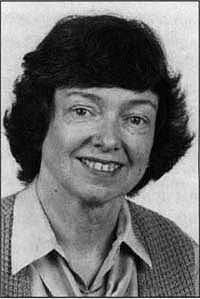All Issues
Q & A: Pat Snow, Home Economist
Publication Information
California Agriculture 50(6):34-35.
Published November 01, 1996
PDF | Citation | Permissions
Abstract
Pat Snow had just earned her bachelor's degree in home economics at UC Berkeley in 1949 when she applied for the position of 4-H home advisor at the Monterey County Cooperative Extension office. “When I first got the job, I told myself I would leave after 2 years if I didn't like it,” Snow said. She retired in 1991 after 42 years. Snow taught clothing construction to women during the early part of her career. She later took on additional home economics and 4-H duties.
Full text
California Agriculture was first published in 1946. UC's College of Agriculture (the predecessor to the Division) was on the brink of a great expansion. As you remember that time, what did society expect from the College of Agriculture?
PS: People expected hands-on, personal help. I went out and visited every new leader in the home. These were 4-H project leaders in clothing, food and nutrition, home furnishing and food preservation. People were not so rushed and were eager for our contact.
People wanted the information we had to offer. They kept gardens and froze or canned their harvest. They sewed clothing and wanted instruction on the finer points. Perhaps because they spent so much time in the home, they did a better job of putting it together and caring for it.
How did those expectations change in subsequent decades and what are they today?
PS: As women went to work, you couldn't really meet with them in their homes. I found there was still interest in food preservation, primarily from the food-safety point of view. Few people had time for sewing. They began doing more crafts. Their interest in home decorating appeared to diminish. Now people call in a decorator, or they just do it themselves. Some are talented and their homes are lovely. Others do what is necessary. They just live there and are working most of the time.
How did you perceive your role as a 4-H advisor when you were hired in 1949? How did your job change over the years?
PS: When I first started, I attended 4-H project meetings during the afternoons and 4-H community club meetings several evenings each week. We offered classes to the home extension women on making coats, man's shirts and wool dresses, to name a few. All of our classes and advice were free.
About the late-1960s, the statewide 4-H office asked us to stop making home visits and attending project meetings. We still went to some night meetings on invitation. The University reduced staff and some rural county populations grew, so our outreach approach changed. We began to rely more on phone calls, newsletters and office calls. The 4-H members and leaders were understanding. They began coming to us more than we were going to them.
In the later years, leaders wanted answers to problems with children. They wanted to come to meetings to discuss them rather than have formal presentations. What should they do about the child who didn't bring materials? Or the child who wanted to play and be disruptive? Leaders who were successful working with children would share their techniques with other leaders and my role became one of facilitator.
What were UC's most significant extension contributions during these years, particularly in your area of expertise or to the industry you served?
PS: Significant impact was made in teaching nutrition and food safety through the 4-H project. A lot of research had been done on vitamins, minerals, fats, cholesterol, and so on, at UC Berkeley. We were sharing this new information with 4-H and the public.
The work done with adults and 4-H members on personal color during the '60s and '70s was also significant. We matched their skin, eyes and hair and determined the specific red that was best for them. Then we extended these colors, making a match-stick fan. An individual could wear any color if it was within this range of value and intensity. People who did this really appeared put together.
How have societal changes over the last 50 years influenced the Division?
PS: As awareness grew about the situation of minorities, the University made every effort to reach more minorities with its programs.
Looking toward the future, what is the most important task for the Division and for UC?
PS: I believe the 4-H program should be expanded to reach as many young people as possible. It's an educational program that gives youth tools they can use all their lives. The experience in public presentations is one of the best aspects of 4-H. The junior leader project, which teaches how to work with others, and the interviews for All Stars and awards, which help prepare them for job interviews, also are great opportunities for 4-H members.





